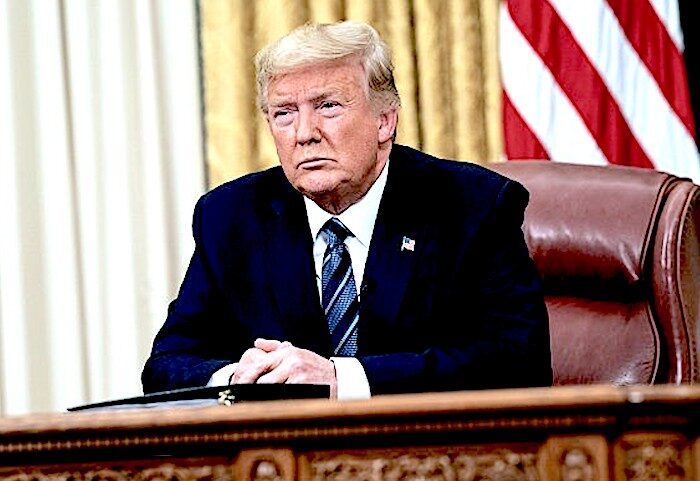
© Joyce N. Boghosian/The White House/FlickrUS President Donald Trump, March 11, 2020
President Donald Trump's Executive Order sets broad changes in the visa worker pipelines that have allowed Fortune 500 companies to import foreign workers into the jobs needed by Americans.
Trump's June 22 announcement is important for Americans' jobs and wages,
but it may become hugely important if it releases a cascade of political activism by U.S. college graduates.1. The policy announcements do not change laws, nor do they create instant regulations. So they need to be rational and modest to overcome resistance from pro-diversity, pro-migrant, establishment judges.
The Executive Order temporarily blocks the arrival of most foreign contract workers and green card legal migrants until December 31, 2020, and it is accompanied by two draft regulations. If Trump wins in November, his order can be extended, and the draft regulations can survive lawsuits.
2. The administration says the Executive Order will open up 525,000 jobs for Americans. Even if the 525,000 estimate is double the reality, it will open 262,500 jobs for Americans and force employers to hire and train more Americans:
3. The order relies on the president's 212(f) authority over the border to block the entry of visa workers via the pipelines created by Congress. It does not expel any of the roughly 1.3 million foreign contract workers who legally hold white-collar jobs in the United States, but i
t blocks the entry of roughly 35,000 H-1B and L-1 white-collar workers, as well as 95,000 J-1 and H-2B blue-collar workers, according to an
estimate by the pro-migration Migration Policy Insitute.
4. The Executive Order continues the April 22 rules that block the arrival of people who can file to get green cards outside the United States. The population should reach 158,000 adults and children by the end of 2020.
5. The Executive Order will be reviewed by administration officials in 30 days. That gives American activists and voters
more opportunities to expand the number of jobs that will be opened to Americans. For example, the Executive Order does little to stop white-collar illegal migration or to curb the award of work permits to foreign graduates of U.S. universities.
6. The order includes several loopholes to help foil lawsuits. For example, companies are allowed to ask [to] import specific workers if they can show those workers are vital.
The loophole forces company lawyers to explain why their claimed foreign workers cannot be replaced by Americans. The loopholes likely will be narrow because the order narrowed an April 22 exception for health care. The narrow version exempts only doctors and scientists who would be directly working on coronavirus cases, and so it excludes doctors and scientists who claim they might work on coronavirus programs.
7. A draft regulation narrows the number of migrants who can get work permits while they wait for asylum hearings or "Adjustment of Status" decisions. This regulation will deny work permits to roughly 25,000 migrants over the next six months — unless a judge blocks the rule. More broadly, the new asylum rules will deter people from migrating to the United States,
so helping to raise wages for blue-collar Americans.8. A second draft regulation changes how H-1B visas are awarded each year. The H-1B visas are now awarded by lottery, which means that Indian-run staffing companies can get as many visas as they want for low-wage H-1Bs if they just submit sufficient applications. The new rules will allocate the 85,000 visas each year to the companies that offer the highest pay. The new rules also say employers must pay median or higher wages to H-1Bs. Both rules will make it very difficult for Indian staffing companies to earn a profit by renting cheap Indian workers to Fortune 500 companies.
This wage reform will allow young American graduates to snag many software jobs that are now quietly reserved for Indian H-1Bs.9. The 212(f) border regulation cannot impact foreign workers already in the United States. This means it does not curb the 600,000 resident H-1Bs or the roughly 500,000 foreign graduates in the Optional Practical Training (OPT) and the Curricular Practical Training (CPT) programs. Congress' laws protect this army of H-1Bs, and the OPT workers are protected by an army of lobbyists from the Fortune 500 and the universities. But the victorious advocates for American programs are now raising their sights to the OPT and CPT programs that allow universities to provide work permits to foreign customers who then get tax breaks to grab the jobs sought by the universities' own American graduates. Most of the wealth generated by the OPT and CPT programs
flow to wealthy coastal states.
10. The Executive Order and the regulations do not curb the little-known B-1 visa program, which is widely used by U.S. employers and their subcontractors
to smuggle many illegal immigrant professionals into U.S. jobs. This potentially huge pipeline of illegal college workers has gotten very little political or media attention, even though
it undermines the wages and status of American graduates.11. The Executive Order and the two regulations are a huge political victory for reform activists and U.S. professionals over the Fortune 500 companies and their cheap-labor contractors. So
it sets the stage for the 2020 election and for 2021 pressure on Congress to rebalance U.S. labor laws in favor of employees — and less in favor of the Fortune 500 and the glamorous, politically powerful tech companies.
Comment: The gains are in redistribution. Companies make money on cheap foreign labor who then send their $ home. American worker paychecks will be reinvested into US economy and taxed. It should be a no-brainer as to which will serve the USA better and longer. Either way, big business survives and profits.